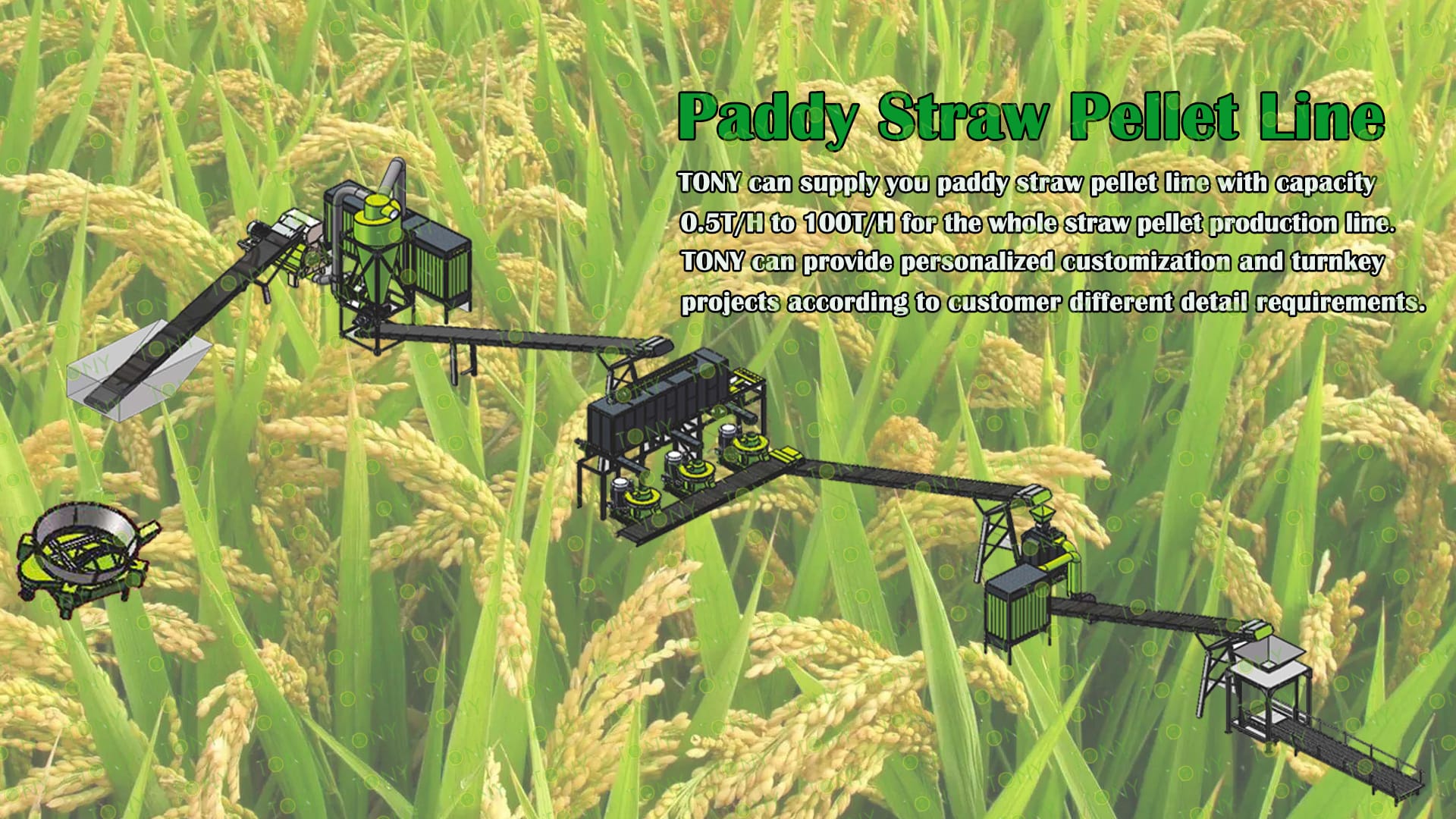
TONY Design 6-8Ton/Hour Paddy Straw Production Line Specification
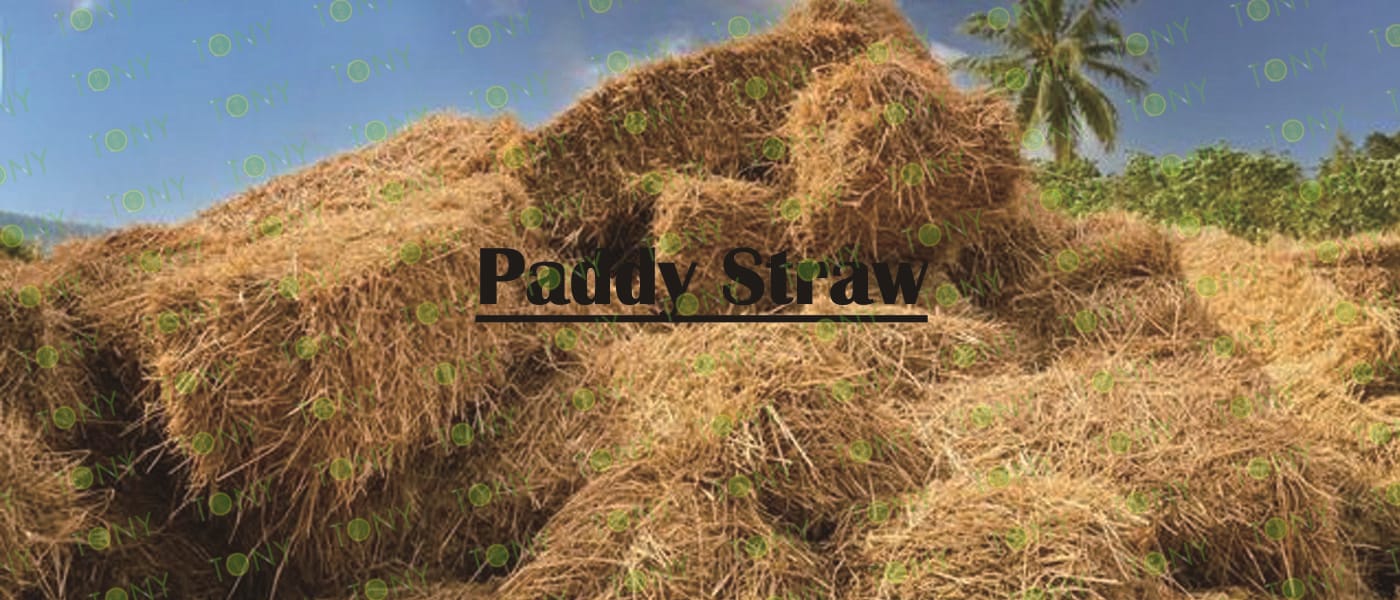
Nearly 300 million tons of rice straw are produced worldwide each year. Due to its large quantity and volume, it is difficult to process in a short time, which affects the sowing of subsequent crops and becomes a thorny problem in production. Rice straw is rich in nitrogen, phosphorus, potassium, calcium, magnesium and organic matter, and is a renewable biological resource with many uses.
Paddy Straw Useful
Feed: Rice straw can be used as feed for herbivorous animals (such as cattle and sheep). After fermentation, its nutritional value and palatability are significantly improved.
Fertilizer: Rice straw can be used as fertilizer for crops. After composting, it is applied to farmland to increase soil fertility.
Energy: Rice straw can be used for the production of biomass energy, such as biogas fermentation raw materials.
Base material: Rice straw can also be used as a culture medium for edible fungi.
Paddy Straw Composition And Characteristics
Rice straw is mainly composed of cellulose, hemicellulose, lignin, and a small amount of minerals and proteins. Although its crude protein content is relatively low, it is rich in crude fiber components such as cellulose, and is a natural source of roughage for ruminants such as cattle and sheep. Untreated rice straw has poor palatability and low digestibility, but its nutritional value can be significantly improved through fermentation treatment.
Current status and challenges of rice straw utilization
Globally, the comprehensive utilization rate of rice straw exceeds 80%, mainly through fertilizer, feed, energy, base material and raw material utilization. 4. However, the high cost of storage and collection has affected the overall benefits and sustainable development of the straw comprehensive utilization industry chain.
In summary, rice straw has a wide range of uses and important economic value worldwide, but its processing and utilization still face some challenges.
Paddy Straw Burning Has Many Disadvantages But No Benefits
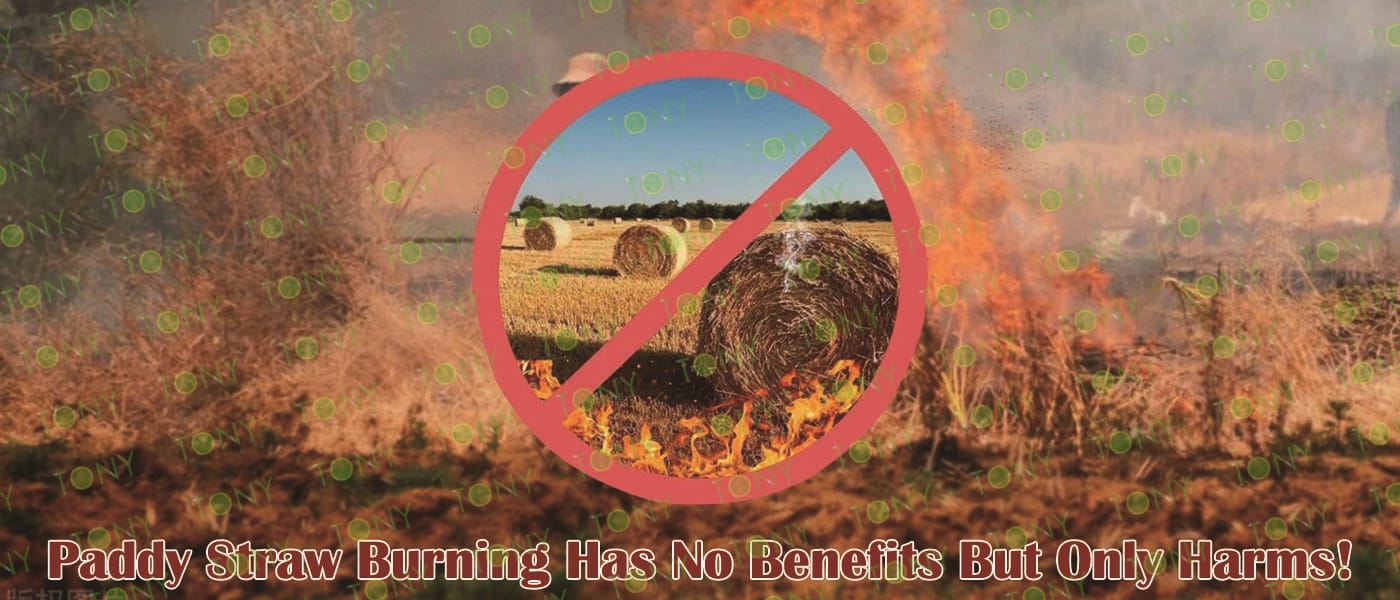
Main disadvantages of burning rice straw include the following aspects:
Air Pollution: Burning rice straw will produce a large amount of harmful gases such as smoke, nitrogen oxides, and carbon dioxide. These gases will not only pollute the air, but also reduce air quality and aggravate global climate change.
Harm To Human Health: The harmful gases and dust produced by burning will affect human health, especially the respiratory system, and may induce or aggravate respiratory diseases such as asthma and pneumonia. Long-term inhalation of these harmful gases may cause symptoms such as coughing, chest tightness, and tears, and may cause bronchitis in severe cases.
Affect Traffic Safety: The smoke formed by burning straw will reduce visibility, affect the normal operation of civil aviation, railways, and highways, and easily cause traffic accidents, affecting personal safety.
Cause Fire: Burning straw can easily ignite surrounding flammable materials, especially in dry seasons. Once out of control, it may cause serious damage to surrounding forests, houses, and farmland.
Destroy Soil Structure: Straw burning will cause the beneficial microorganisms in the soil to be burned to death, humus and organic matter to be mineralized, destroy the balance of the soil's biological system, change the physical properties of the soil, and affect the growth and yield of crops. Destroy the ecological environment: Straw burning will destroy the ecological balance, affect the habitat of wild animals, and reduce biodiversity. In order to reduce the harm of rice straw burning, the following measures can be taken: Return straw to the field: Return straw directly to the field to increase soil organic matter and improve soil structure. Biomass energy utilization: Use straw for biomass power generation or production of biofuels. Feed utilization: Use straw as feed for animal husbandry. Base material utilization: Use straw as a base material for edible fungus cultivation. Compost utilization: Compost straw for agricultural production. Through these measures, the harm of rice straw burning can be effectively reduced, and resource recycling and environmental protection can be achieved.


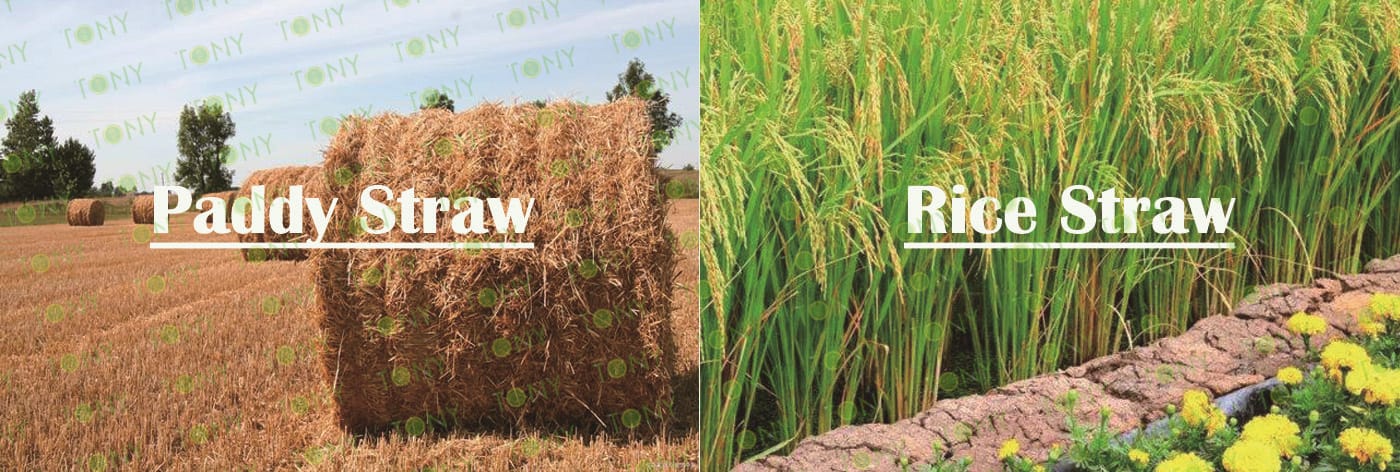
The main reason for producing pellets from Paddy straw is to reduce environmental pressure and provide new resources for agricultural production. As agricultural waste, Paddy straw will burden the environment if it is not used. By producing pellets, Paddy straw can be converted into high-value fuel and organic fertilizer, reducing environmental pollution while providing new resources for agricultural production.
Specifically, there are several advantages of producing pellets from Paddy straw:
1.Reducing Environmental Pressure: If Paddy straw is not properly handled, it may be burned or discarded at will, causing air and water pollution. By producing pellets, Paddy straw can be processed centrally to reduce environmental pollution.
2.Providing New Resources: Paddy straw pellets can be used as fuel, with the characteristics of high calorific value and low pollution, meeting energy needs. In addition, Paddy straw can also be processed into organic fertilizer to improve soil fertility and soil structure.
3.Increasing Farmers' Income: The production of Paddy straw pellets not only protects the environment, but also provides farmers with an additional source of income. It is an environmental protection policy that the country strongly supports.
In summary, producing pellets from Paddy straw not only helps environmental protection and resource reuse, but also brings new opportunities and economic benefits to agricultural production.
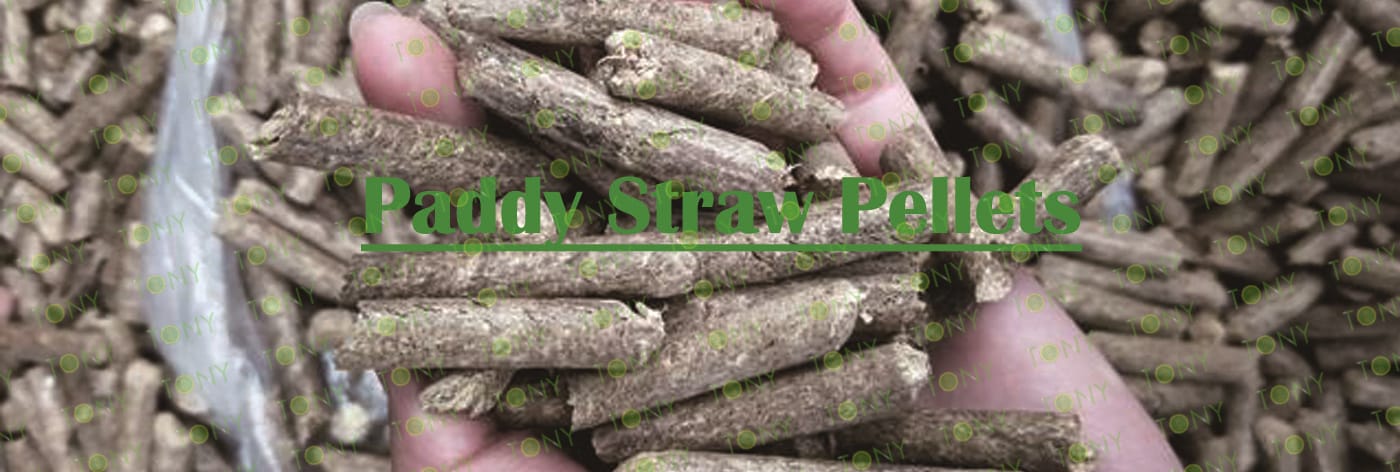
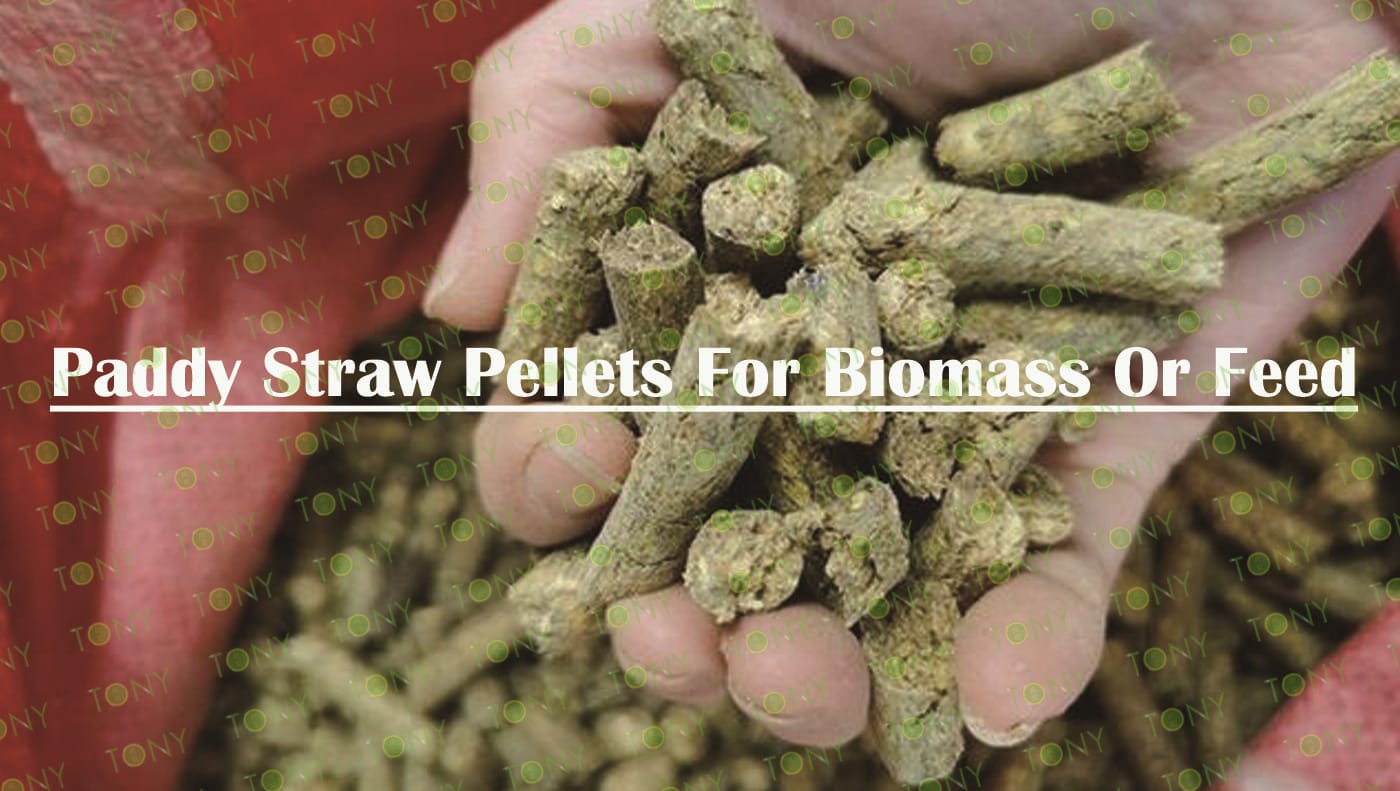
Some factors affecting the yield of paddy straw pellets
1.The main factors affecting the yield of paddy straw pellets include raw material selection, raw material pretreatment, equipment configuration and ratio adjustment.
First of all, raw material selection is one of the key factors affecting the yield of paddy straw pellets. The type and quality of raw materials directly affect the output and quality of pellets. For example, when paddy straw is used as raw material, clean and impurity-free straw needs to be selected to ensure the density and molding effect of the particles1. In addition, the moisture content of the raw materials is also very important. Excessive moisture content will cause wall sticking during the granulation process and affect the output.
Secondly, raw material pretreatment is also an important factor affecting output. Impurities and moisture content in the raw materials will affect the molding effect and output of the particles. Through pre-treatment methods such as crushing and screening, impurities can be removed and the uniformity of raw materials can be improved, thereby increasing particle yield.
2.Equipment configuration is also an important aspect that affects output. The design and automation level of biomass pellet equipment directly affect production efficiency and output. Reasonable equipment configuration and advanced process flow can significantly improve production efficiency and particle quality.
3.Finally, proportion adjustment is also a key factor affecting output. During the production process, the ratio of raw materials needs to be continuously adjusted and optimized to ensure the best molding effect and output. For example, the proportions of raw materials such as wood chips and paddy husks need to be adjusted according to specific conditions to achieve optimal yield and quality.
By optimizing raw material selection, pretreatment, equipment configuration and ratio adjustment, the yield and quality of paddy straw pellets can be effectively improved.
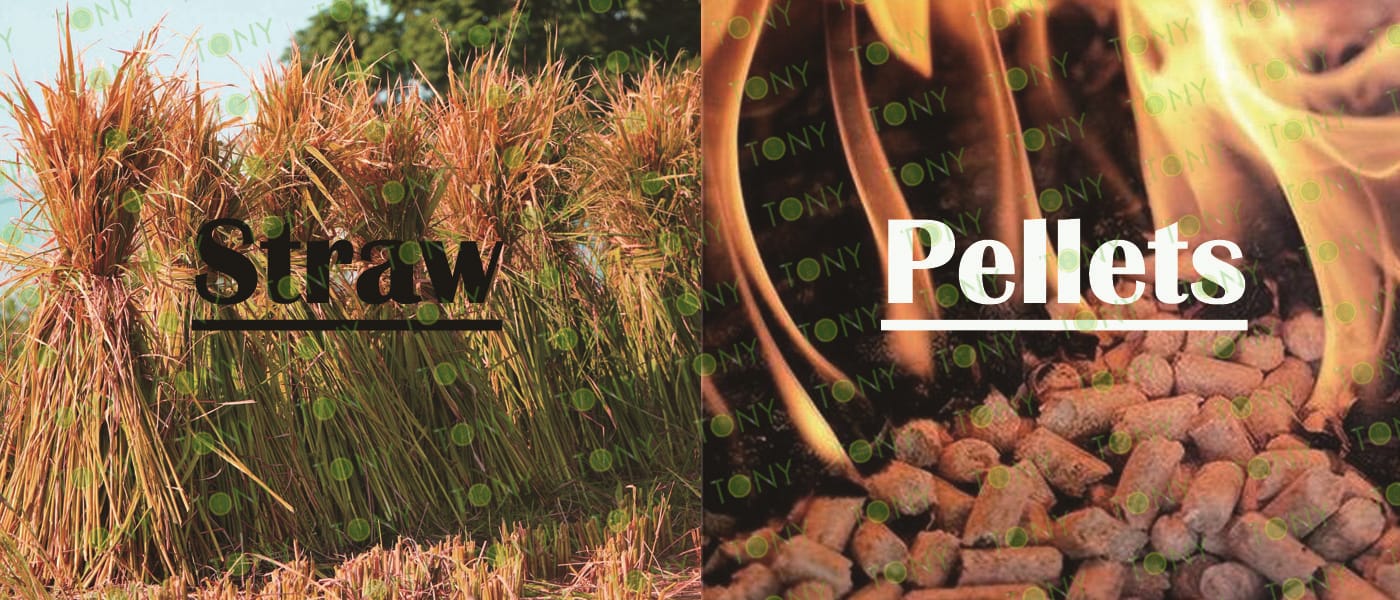

The economic value of rice straw pellets is mainly reflected in the following aspects:
Feed Utilization: After the rice straw is pelletized, nutrients of different formulas can be added to make feed with higher nutritional value. This feed is not only convenient to transport and store, but also has higher nutritional value and is suitable for goats and other livestock. In addition, rice straw can also be nitrogenated by microbial fermentation agents to reduce the cellulose content and increase the nutrient content, further enhancing its utilization value as feed.
Biomass Energy: Rice straw pellets can be used as biomass fuel to replace non-renewable fuels such as coal and oil. Using mature technologies such as straw briquetting and pelleting, biomass "pellet" fuel can be made, which has good economic, environmental and social benefits. This fuel is not only environmentally friendly, but also reduces dependence on fossil fuels and reduces energy costs.
Economic Benefits: The use of rice straw pellets can drive local economic development. For example, Liuhe Town consumes a large amount of straw to produce feed through straw processing and utilization enterprises, and sells it to other places, which has driven the development of the local economy. In addition, rice straw pellets can also be used for heating, reducing the use of coal and lowering heating costs.
Specific Application cases of rice straw pellets:
Feed Utilization: In the demonstration project of the Zhenjiang Agricultural Science Institute in Jiangsu Province, early-maturing rice straw is pelletized, and then microbial fermentation agents and nitrogen treatment are added to make the feed with higher nutritional value, making it a delicacy for goats.
Biomass Energy actively promotes the project of straw clean energy into farmers, uses mature technologies such as straw briquetting and pellets, implements the project of straw clean energy into farmers, distributes biomass stoves, and promotes farmers to use clean energy.
In summary, rice straw pellets not only have significant economic value in terms of feed and biomass energy, but also can drive local economic development and reduce dependence on fossil fuels, and have broad application prospects.

The development prospects of paddy straw pellets are generally positive, with broad market potential and environmental benefits. As a high-calorie, clean and environmentally friendly fuel, paddy straw pellets are mainly made of biomass resources such as straw and paddy straw, which can solve the problem of waste disposal in rural and urban areas, while bringing considerable returns to investors.
The production of paddy straw pellets utilizes rural and urban waste, such as straw, paddy straw, waste wood, etc., which not only helps to solve the problem of waste disposal, but also reduces environmental pollution. The raw materials for producing paddy straw pellets are widely available, the cost is low, and it has high ecological, economic and social benefits. paddy straw pellet fuel can be used in many fields, including industrial production and heating, providing clean energy for industrial enterprises and residents. With the increase in demand for renewable energy, the market demand for paddy straw pellet fuel is also gradually growing, especially in the context of increasing environmental awareness, its application prospects are even broader.

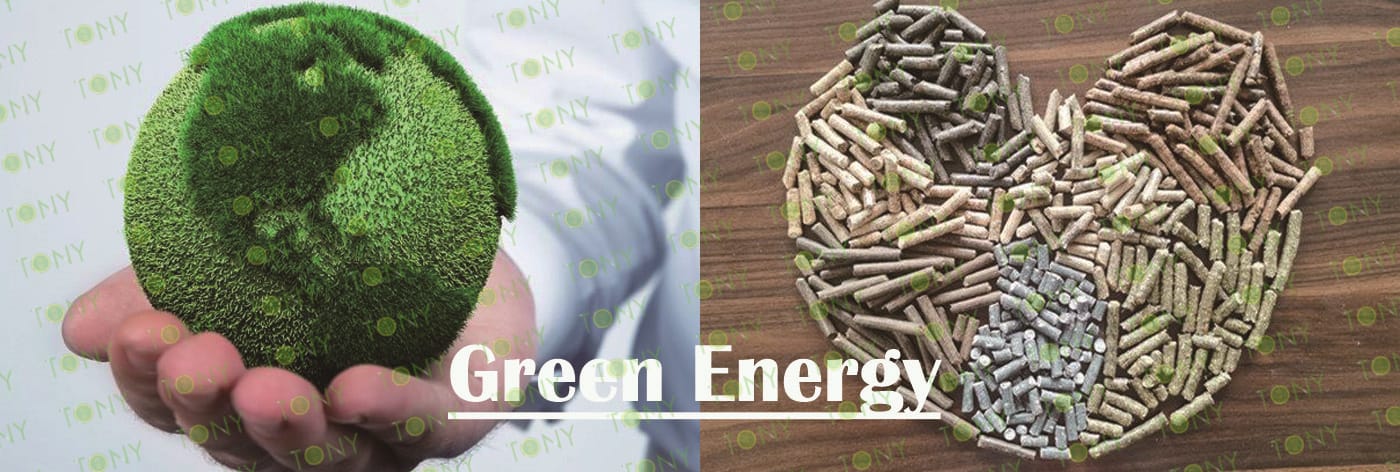
1. Current Market Demand For Paddy Straw Pellet Fuel
At present, Paddy straw pellet fuel has not been popularized in most parts of my country. The main reasons are low market awareness, imbalance between supply and demand, and immature technology. However, with the country's policy advocacy and industrial support for green and environmentally friendly energy, the market demand for straw pellet fuel is gradually increasing. According to Zhilian data, the current market demand for straw pellet fuel has reached millions of tons, while the supply accounts for only about 2% of the national bamboo production, and the contradiction between market supply and demand is more prominent.
2. Analysis Of The Market Prospects For Paddy Straw Pellet Fuel
As a renewable fuel, Paddy straw pellet fuel has broad market prospects. First, Paddy straw pellet fuel is in line with the country's policy orientation on environmentally friendly green energy, and the market demand prospects are broad. Secondly, Paddy straw pellet fuel is highly versatile and can be used for a variety of purposes such as home heating, industrial heating, and power machinery fuel, and the market space is huge. In addition, the production and transportation costs of Paddy straw pellet fuel are relatively low, and it has a large market ppaddy advantage. In addition, with the maturity of technology, the continuous improvement of production efficiency and output, the competitiveness of straw pellet fuel will continue to improve in the future.
In short, the market prospects of Paddy straw pellet fuel are broad, and its status will continue to improve with the development of China's economy and changes in the policy environment. At present, relevant industrial enterprises need to further strengthen technology research and development, improve product quality, improve the market supply chain, and ensure market prospects and production and sales market share.

1.Working Principle Of Paddy Straw Biomass Pellet Processing Equipment
The working process of the equipment includes the following main steps:
Feeding Stage: The raw materials enter the equipment through the feed port and are ready for the next step of processing.
Preliminary Crushing: Before the raw materials enter the compression chamber, they usually need to undergo preliminary crushing to ensure that the raw material particles are uniform in size, which is convenient for subsequent high-pressure compression and molding.
High-Pressure Compression: After the raw materials enter the compression chamber, they are subjected to strong compression force and are squeezed into strips or other shapes to enhance the bonding force between the particles.
High-Temperature Treatment: The compressed raw materials enter the high-temperature furnace for heat treatment to promote the pyrolysis and polymerization of components such as lignin, and further improve the calorific value and corrosion resistance of the particles.
Cooling And Molding: The raw materials after high-temperature treatment need to be cooled by the cooling system to prevent overheating, deformation or combustion, and then molded into regular granular solid fuels under the action of the mold or extrusion plate.
Discharging Stage: The molded particles are discharged through the discharge port to become the final biomass pellet fuel product.
2. Characteristics Of Paddy Straw Pellet Processing Equipment
1. Paddy straw pellet processing equipment has the characteristics of high efficiency and low energy consumption. It can quickly process biomass raw materials into fuel pellets, which improves production efficiency.
2.The pellet machine has molds of various specifications, and can select corresponding molds for processing according to different biomass raw materials, which improves the adaptability of processing.
3.The equipment for processing biomass pellets has the characteristics of high automation and good safety, which effectively reduces labor intensity and improves production efficiency.
4.The granular biomass fuel processed by thepaddy straw pellet processing equipment has stable quality and specifications, which meets the production standard requirements.

TONY Brand 6-8Ton/Hour paddy straw pellet manufacturing plant can process paddy straw ,stlak,It is widely used in poultry feed, cattle, sheep and horse feed. It can also replace coal for burning.
1.Capacity: 6-8Ton/Hour
2.Raw Materials: paddy straw etc.
3.Moisture: About 10-15%.
4.Application: All kinds of straw materials.
5.Finisheh pellets Markets:Feed, fertilizer and fuel fields

1.Project Name: Paddy Straw Pellet Line
2.Raw Materisl: Paddy straw
3.Moisture Of Raw Material: 10-15%
4.Capacity: 6-8Ton/Hour
5.Process: 1.Grinding Process→2.Fine Crushing Process→3.Pelleting Process→4.Cooling Process→5.Packing Process
6.Main Machine: Rotary Cutter,Dual Shaft Hammer Mill, TONY Pellet MachineTYJ551-III-132KW,Pellets Cooler,Packing Machine And Belt Conveyors.
7.Total Power: About 950KW
8.Need Area: About 1200-1400m㎡
9.Project Country: Sri Lanka
10.Voltage: 380V,60HZ


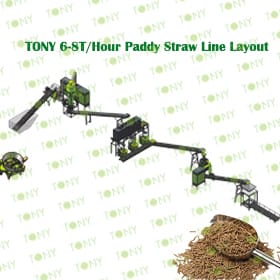 |
Project Layout For Customer |
|
1.Product:Paddy Straw Pellets Line 2.Capacity:6-8T/Hour 3.TONY Brand 6-8Ton/Hour Paddy Straw Pellet Line Project Process 4:Main Machine: :Rotary Cutter,Dual Shaft Hammer Mill, TONY Pellet MachineTYJ551-III-132KW,Pellets Cooler,Packing Machine And Belt Conveyors. 5.Total Power: About 950KW 6.Need Area: About 1200-1400m㎡ 7.Country: Sri Lanka |


|
How to use TONY pellet line to proceed from Paddy Straw into pellets? It mainly contains the following steps and machines as following: 1.To Use TONY Rotary Cutter To Grind Paddy Straw Into 35-45mm straw Pieces. 2.To Use TONY Dual Shaft Hammer Mill To Crush 35-45mm straw Pieces Into 8-14mm Sawdust. 3.To Use TONY Vertical Ring Die Pellet Machine To Products Pellets With φ6-8mm. 4.To Use TONY Galvanized Cooler To Cool Pellets From 80-90℃ to 20-30℃. 5.To Use TONY Semi-Auto Packing Machine To Packing Pellets To 15-50KG/Bags. You can Contact TONY For More Details. |
|
|||||||||||||||||||||||||||||||||||||||||||||
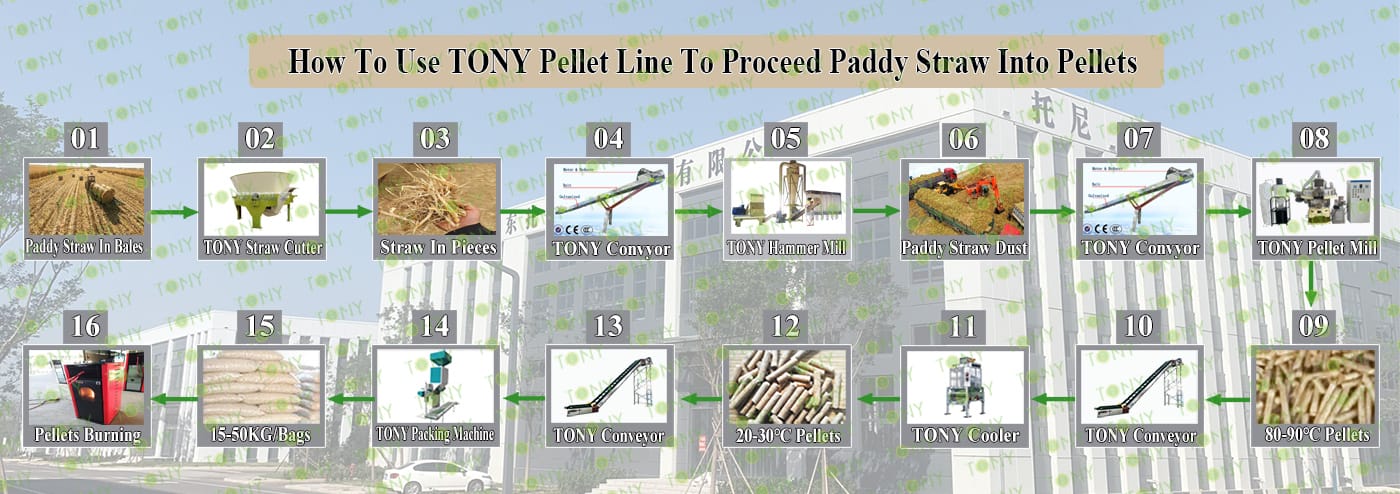



Following TONY Will Introduce For You For All The Necessary Machinery That Will Be Used For The Whole Pellet Production Line. Some machines can be custom made by customer according to different customer's detailed demand.Contact TONY for more details with quotation and layout.
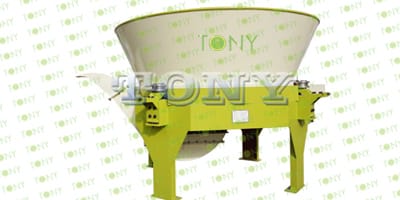 |
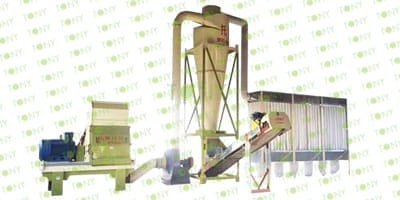 |
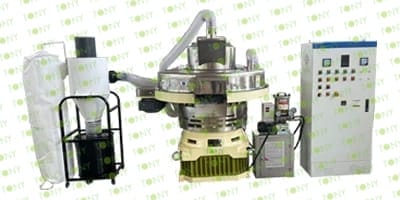 |
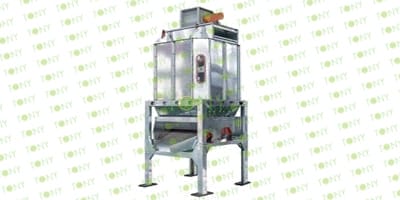 |
| Straw Cutter | High Efficient Hammer Mill | Vertical Ring Die Sawdust Pellet Machine | Galvanised Cooler Separator |
|
1.To Grind Corn Straw Bales Diameter <2.5m Into 60-70mm Pieces 2.Model:TPX3000-2blades-24hammers 3.Capacity:6-12Ton/Hour/Sets |
1.Crush 60-70mm Pieces Into 8-14mm Sawdust. 2.Model:TFS-65-100-110KW*1Set 3.Capacity:6-8Ton/Hour/Set |
1.Model: TYJ551-Ⅲ-132KW*3 Sets 2.Capacity:2-2.5Ton/Hour/Set 3.New 304SS Type |
1.To Cool Pellets From 80-90℃ to 20-30℃ 2.Model:TLN-4 3.Capacity:6-8Ton/Hour |
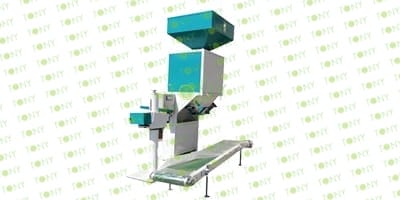 |
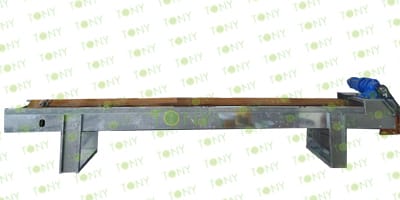 |
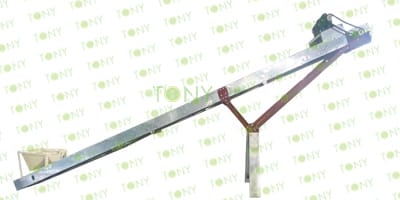 |
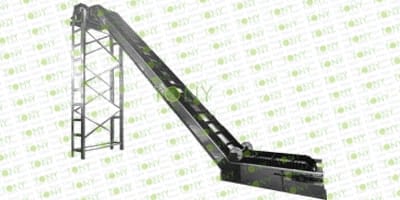 |
| Semi- Auto Packing Machine | Horizontal Belt Conveyor | Belt Conveyor | Belt Conveyor |
|
1.Packing Pellets To 15-50KG/Bags. 2.Model:TBF-50 3.Capacity:6-8Ton/Hour |
1.Transport Pellets. 2.Width:80cm *1Sets 3.Capacity:Designed With The Whole Line |
1.Transport straw pieces and sawdust. 2.Width:80cm*3Sets 3.Capacity:Designed With The Whole Line |
1.Transport Pellets. 2.Width:80cm *2 Sets 3.Capacity:Designed With The Whole Line |



|
1.Grinding Process: A.This process is mainly used to grind the paddy straw into paddy straw pieces with size 25-35mm. The finish straw pieces size can be adjustable by changing different sizes of screeners and adding flying knives inside the wood chipper. B.This customer use TONY Brand TPX-3000 model with 6 flying baldes type: Main Parts: 1).TONY's new Rotary Cutter. 2). Feed and unload belt frequency control to prevent card material 3). Hydraulic system control for more thickness of raw materials 4). Electronic control system allows the equipment to be used normally 5).Contact TONY for more details with quotation. |

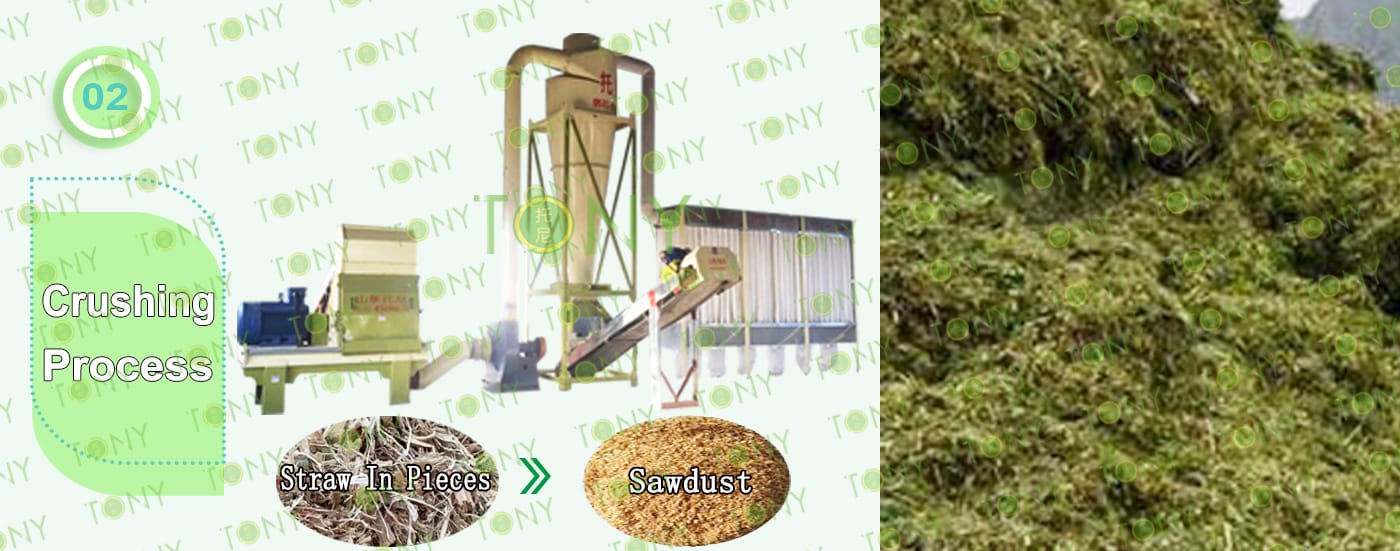
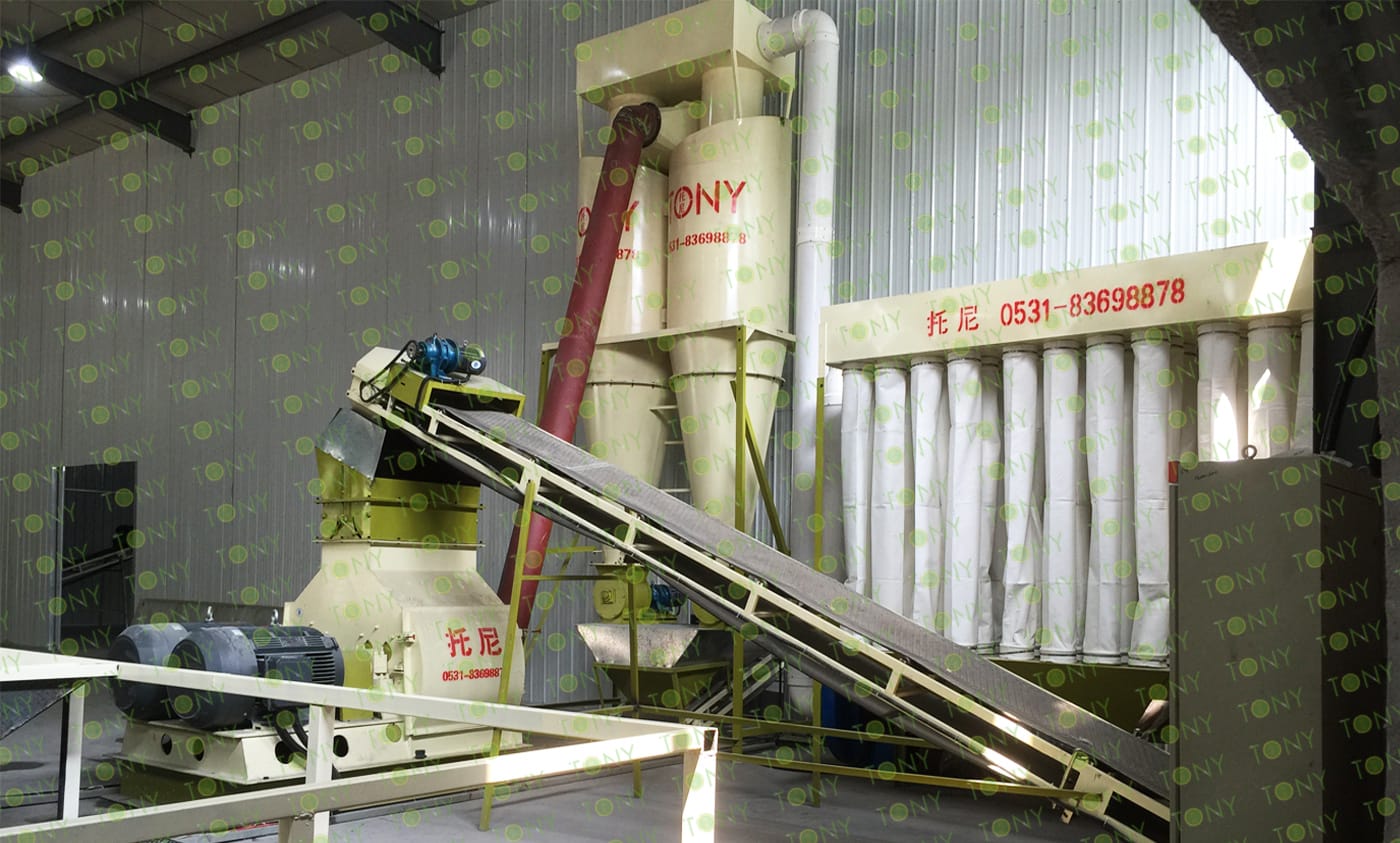
|
2.Straw Pieces Fine Crushing Process: A. This process is mainly used to Crush 30-40mm Straw Pieces Into 8-14mm Sawdust. B. Capacity:6-8Ton/Hour. C. TONY use Dual Shaft high effective Hammer Mill TFS65-100-110kw1Set for this process. Main Parts: 1). TONY Dual Shaft High effective hammer mil. 2). 90Holes Galvanized Dust Collector. 3). Sawdust Transportation Fan Blower. 4). Cyclone With Airlock. 5). Electrical Cabinets. |

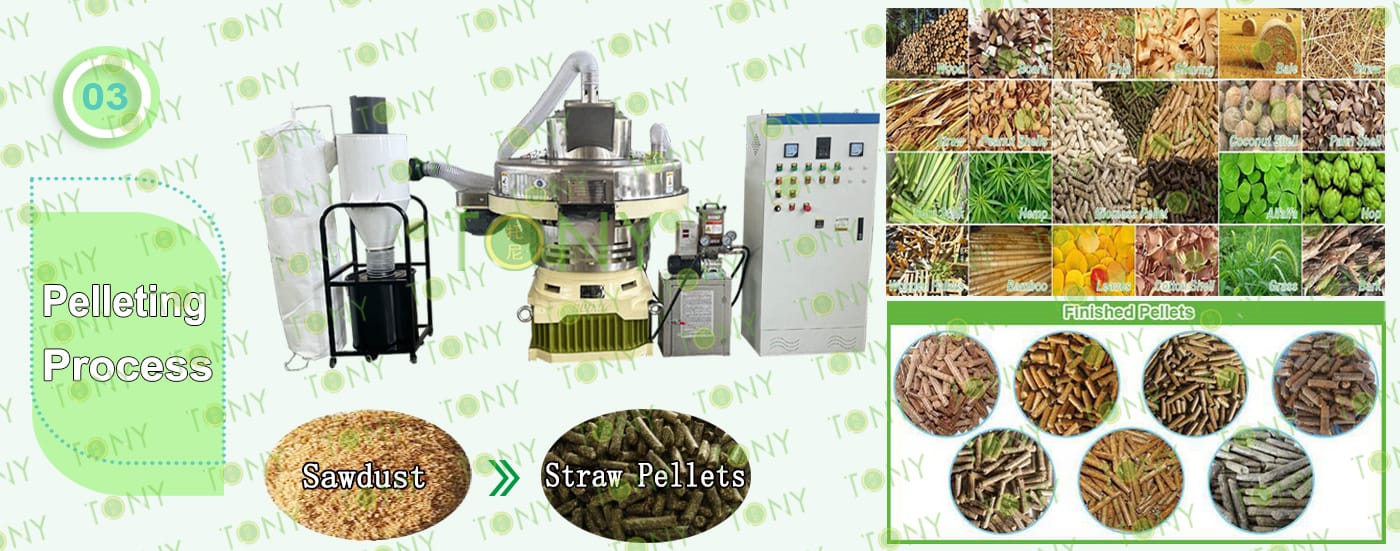
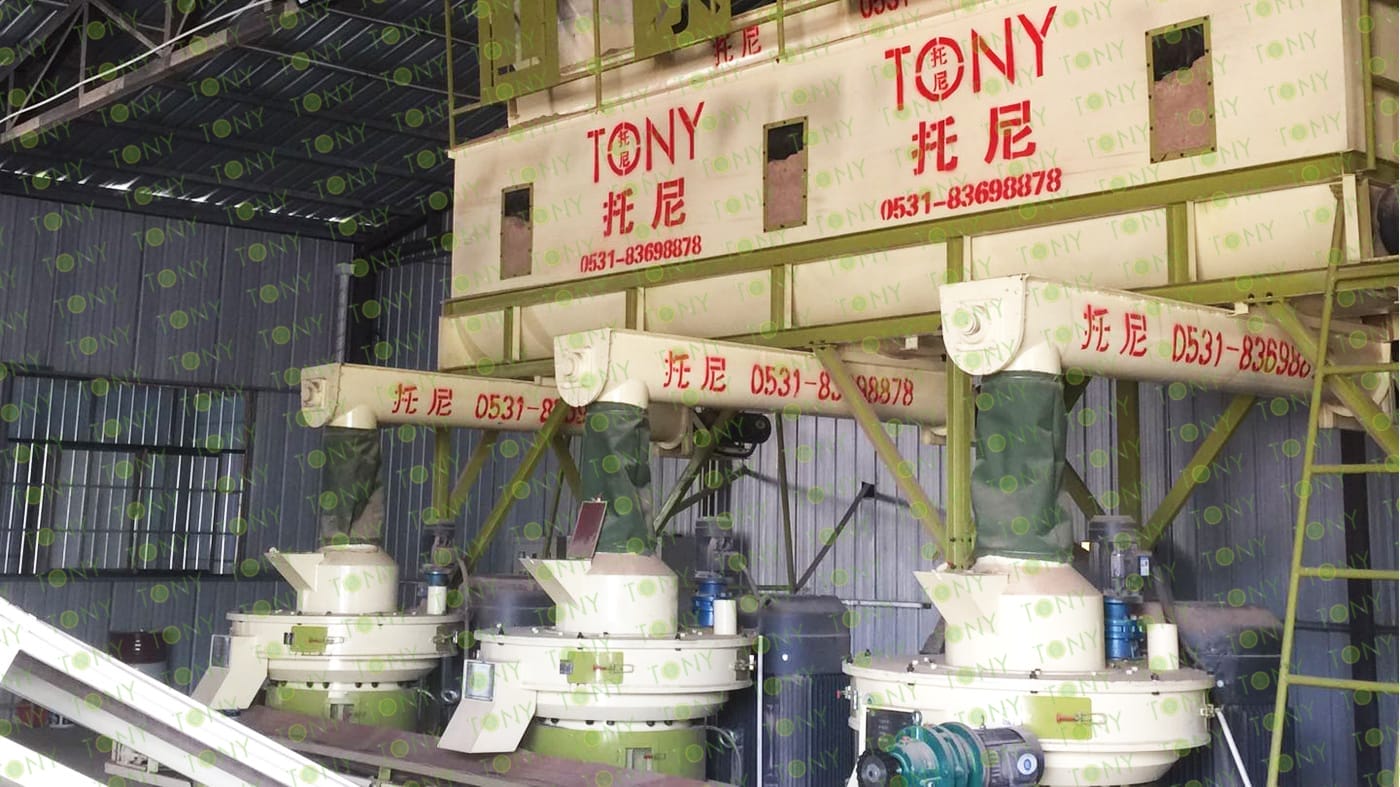
|
3.Pelleting Process: A. This process is mainly used to To Products Pellets With φ6-8mm. B. Capacity:6-8Ton/Hour. C. The Customer Chose 3 Sets Of TONY Brand Vertical Ring Die Pellet Machine TYJ551-III-132KW With Capacity 2-2.5Ton/Hour. Main Parts: 1). TONY's new vertical ring die pellet machine 2). Cyclone and bags dust collectors. 3). Bearings automatic lubrication system. 4). Electrical cabinets. You can chose TONY new type SS304 pellet machine or old type MS pellet machine. |

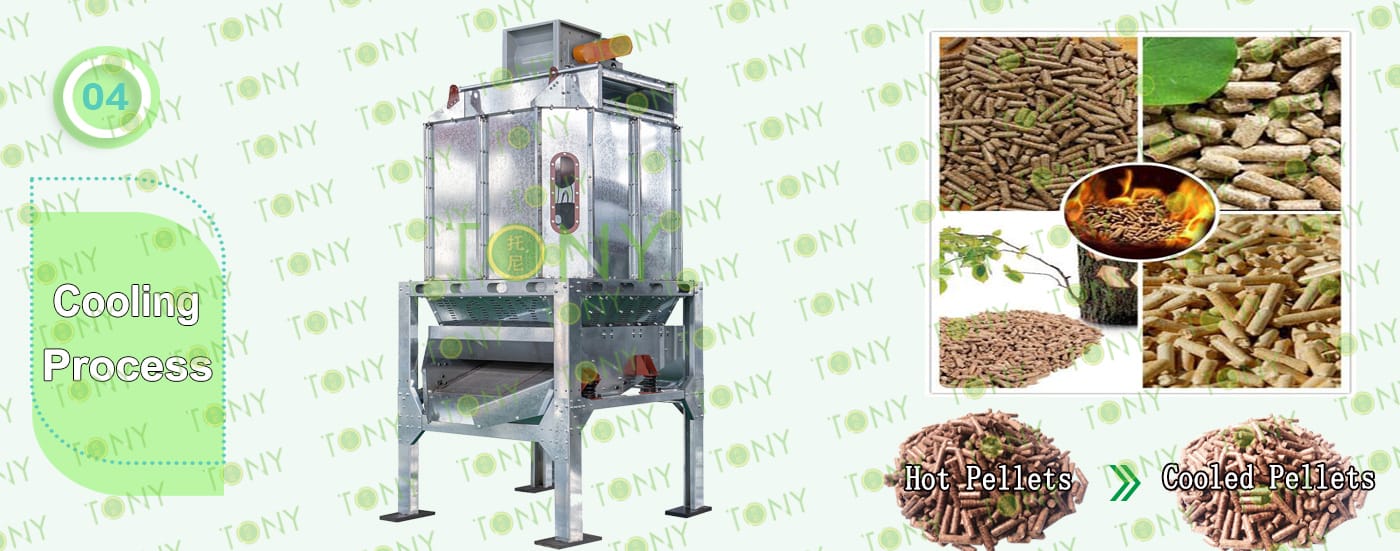
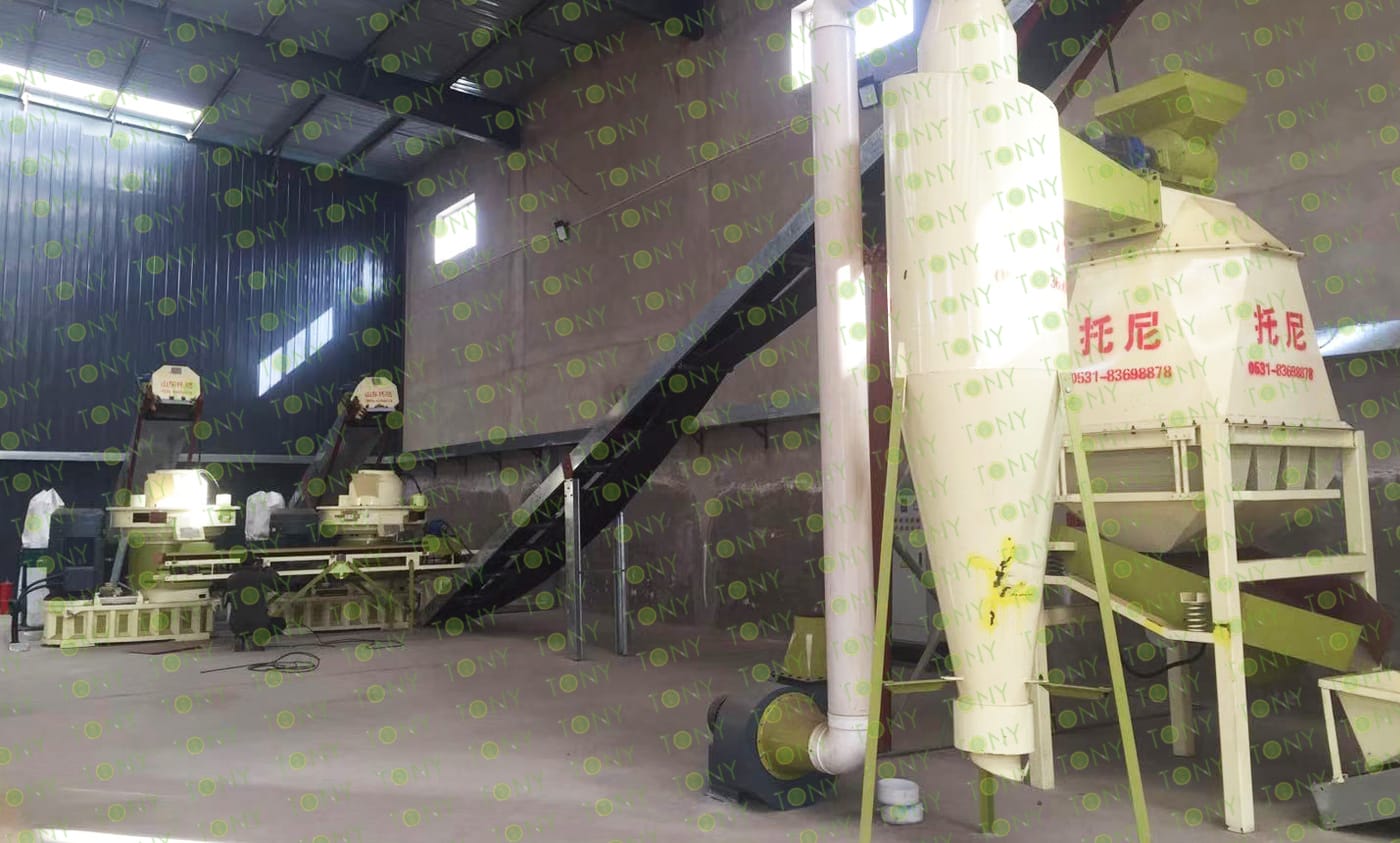
4.Cooling Process:
A.This process is mainly used to cool pellets from 80-90℃ to 20-30℃
B.The customer chooses 1 Set Of TONY Galvanized Cooler Separator with capacity 6-8Ton/Hour.
Main Parts:
1).TONY's new Galvanized Cooler Separator With Vibrating Screen.
2). Cyclone And Bags Dust Collectors.
3). Fan Blower.
4). Connect Pipes.

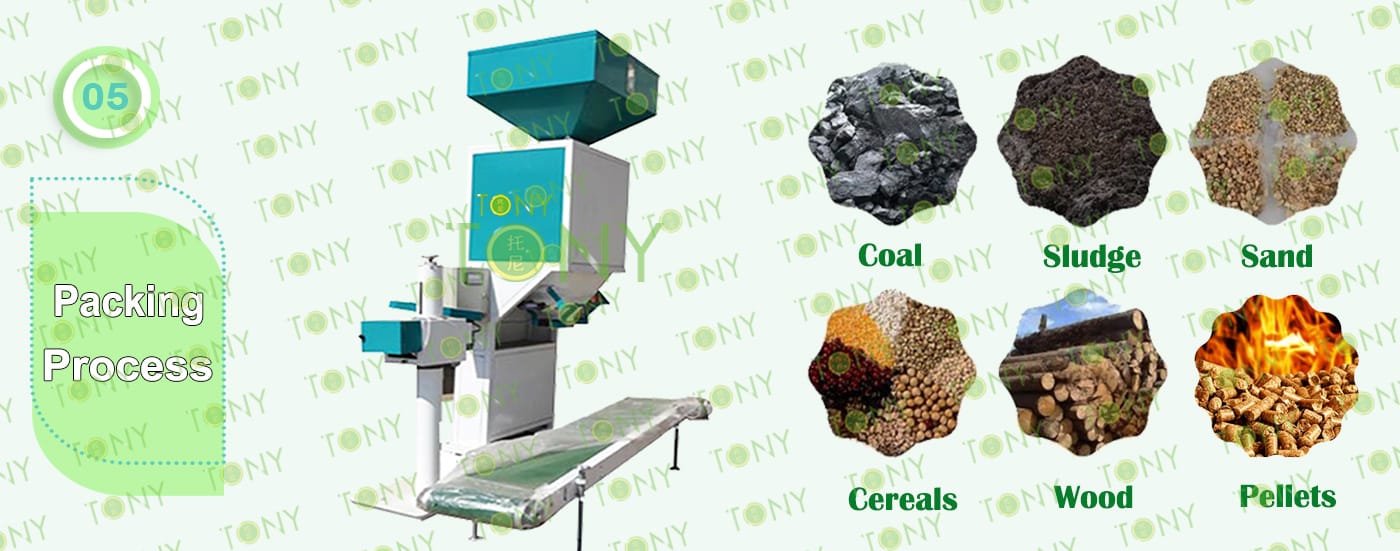
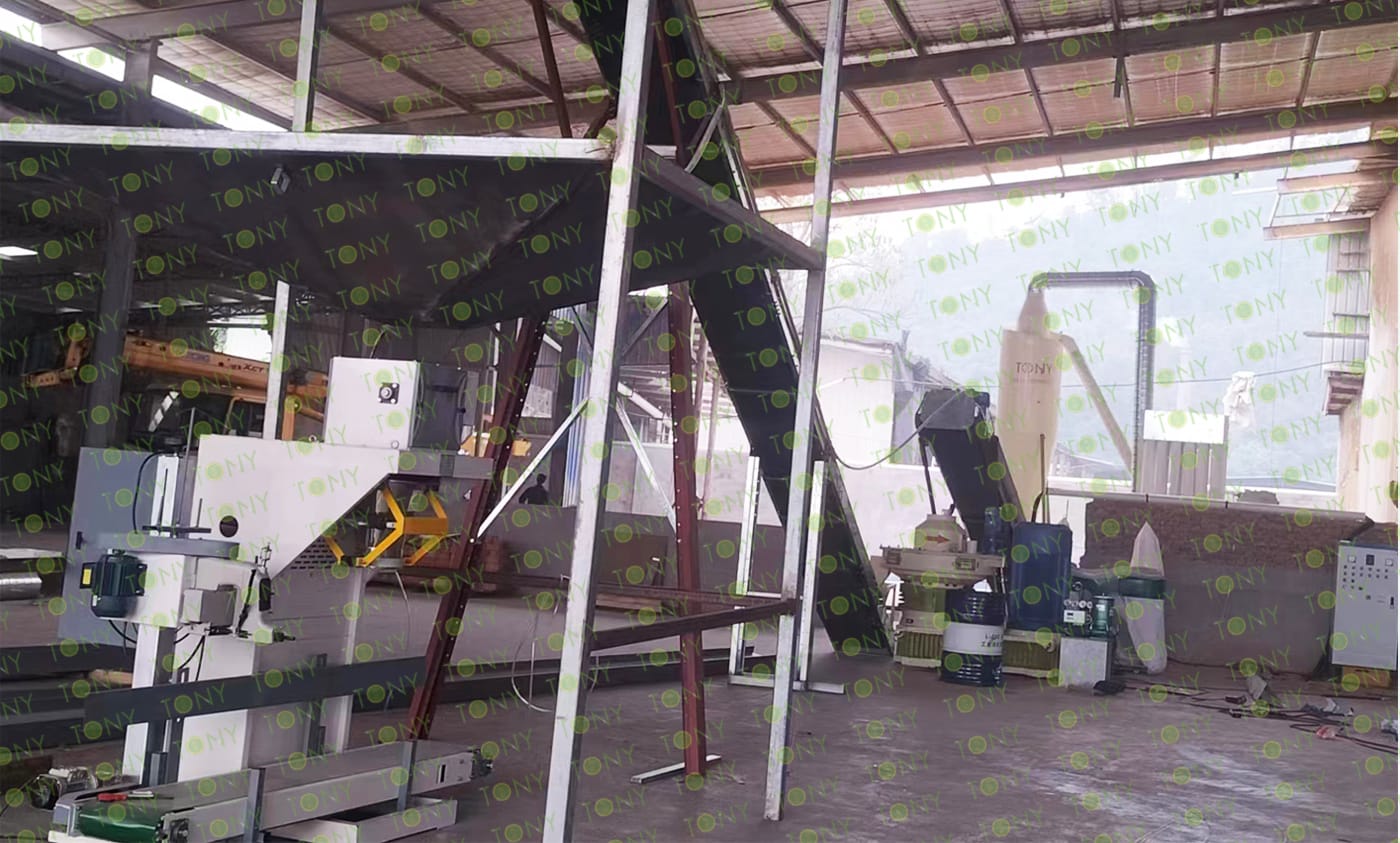
5.Packing Process:
B.The customer chooses 1 set Of TONY Semi-Automatic Packing Machine With 6-8Ton/Hour.
Main Parts:
1)TONY's new TONY Semi-Automatic Packing Machine.
2)Sew Machine, Buyer Can Also Chose Hot Seal Machine For Chosen,To Confirm With TONY For The Ppaddy Difference.
3)Bags Transportation Conveyors.
4)Feeding Inlet Silo With 1㎥.
5)Electrical Cabinets.

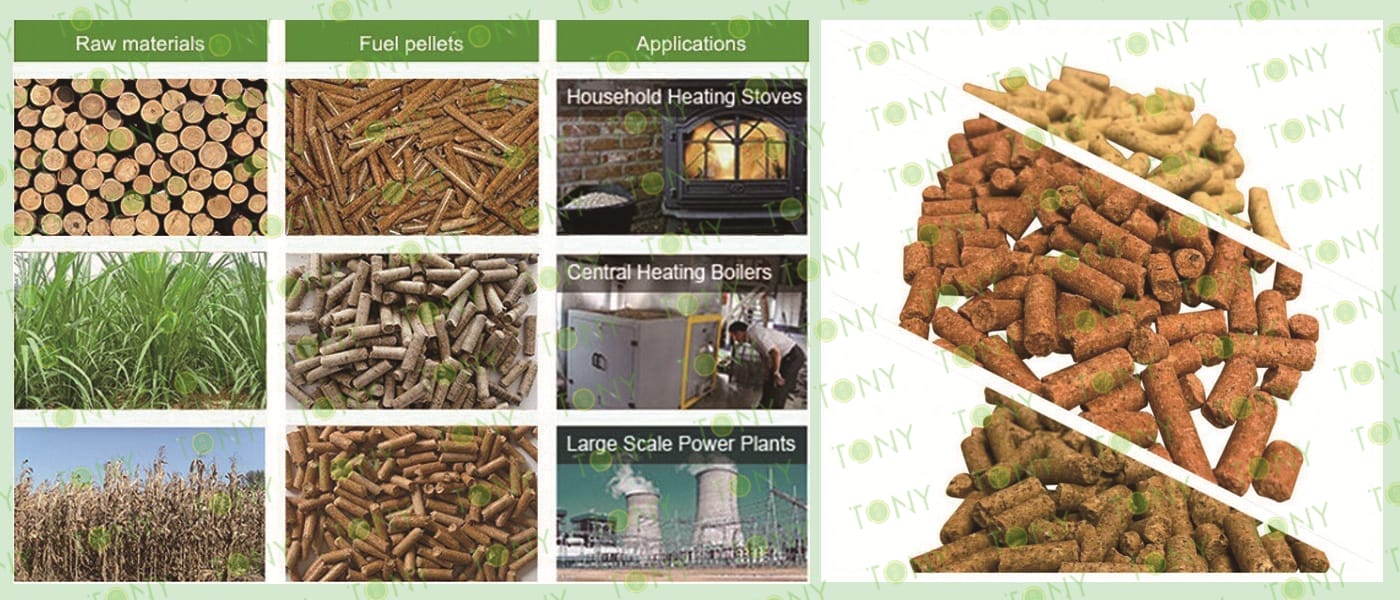

TONY Detailed Design 3D Layout With Detailed Size For 6-8Ton/Hour Paddy Straw Pellet Line According To Cusomer Factor Size


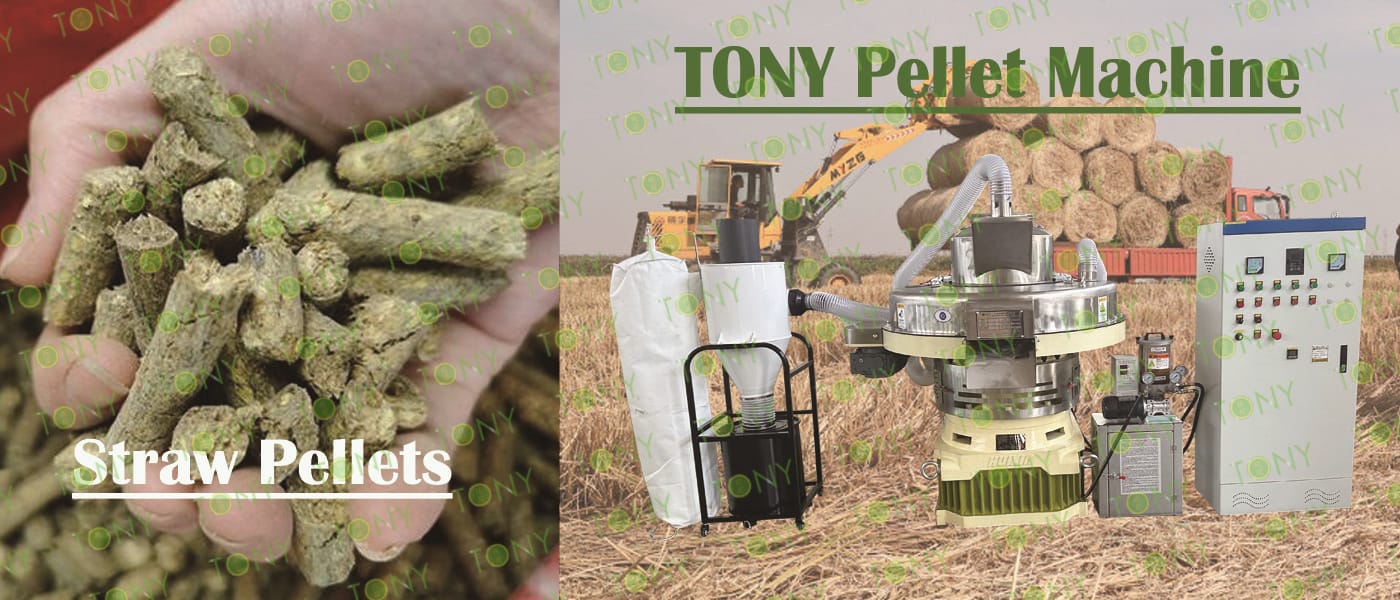

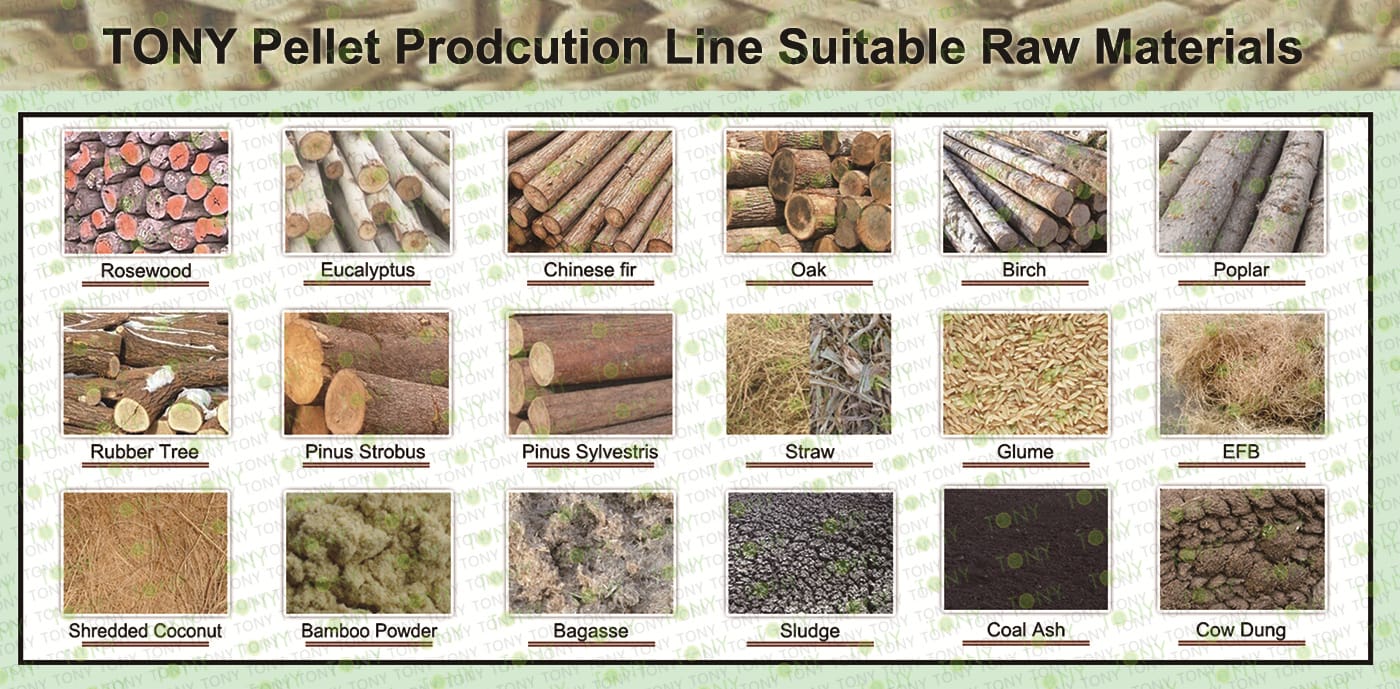
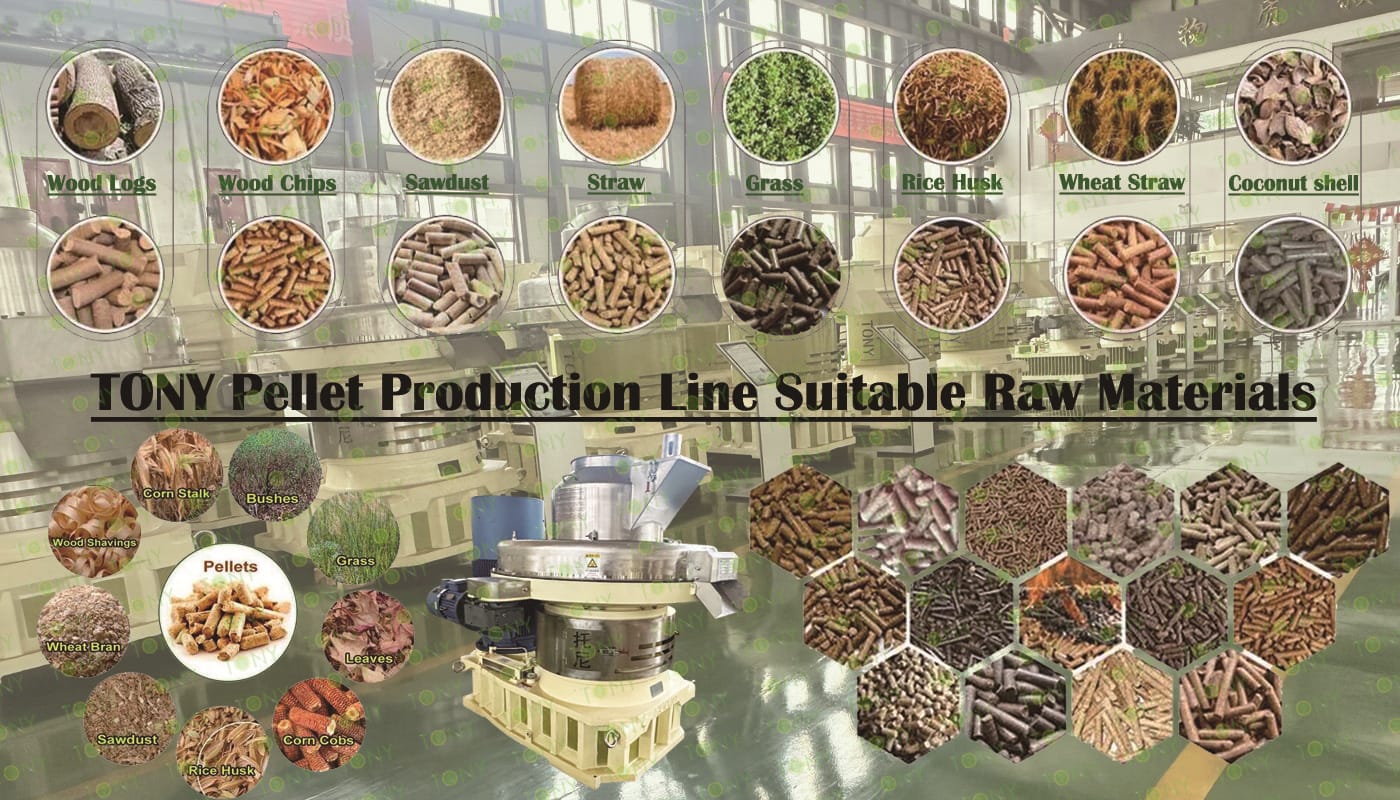

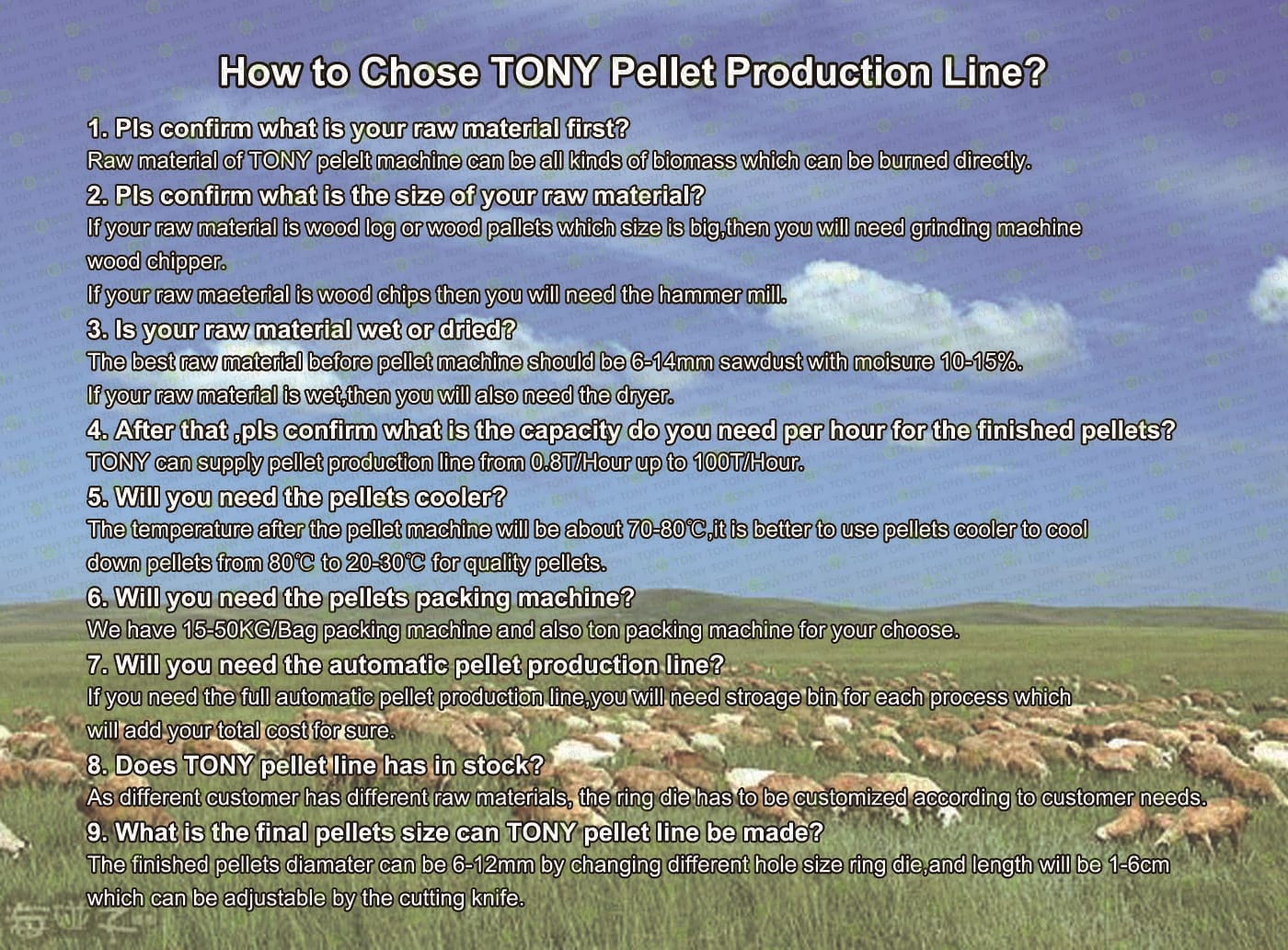

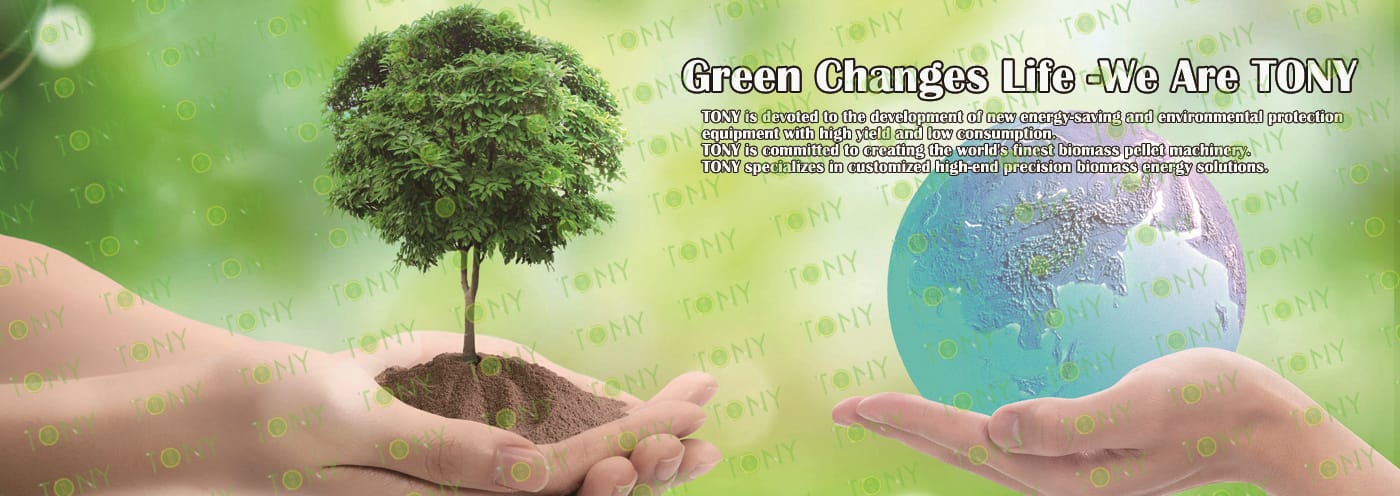
2025 Tony Machinery - All Rights Reserved. Map